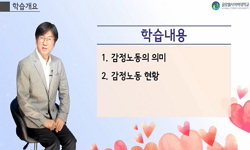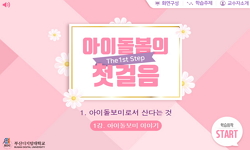This study apprehended the influence of emotional labor and hardiness of long-term care hospital nurses on job satisfaction to verify the emotional labor and hardiness of nurses and apprehend the influential factors to job satisfaction, and attempted ...
http://chineseinput.net/에서 pinyin(병음)방식으로 중국어를 변환할 수 있습니다.
변환된 중국어를 복사하여 사용하시면 됩니다.
- 中文 을 입력하시려면 zhongwen을 입력하시고 space를누르시면됩니다.
- 北京 을 입력하시려면 beijing을 입력하시고 space를 누르시면 됩니다.
https://www.riss.kr/link?id=T14687401
- 저자
-
발행사항
부산 : 부산가톨릭대학교, 2018
-
학위논문사항
학위논문(석사) -- 부산가톨릭대학교 대학원 , 간호학과 노인간호전공 , 2018
-
발행연도
2018
-
작성언어
한국어
- 주제어
-
KDC
512.8698 판사항(6)
-
DDC
618.970231 판사항(23)
-
발행국(도시)
부산
-
형태사항
v, 51장 ; 26 cm
-
일반주기명
지도교수: 서지영
권말부록 수록
참고문헌: 장 37-41 - 소장기관
-
0
상세조회 -
0
다운로드
부가정보
다국어 초록 (Multilingual Abstract)
This study apprehended the influence of emotional labor and hardiness of long-term care hospital nurses on job satisfaction to verify the emotional labor and hardiness of nurses and apprehend the influential factors to job satisfaction, and attempted to provided basic data of mediation development to improve job satisfaction.
This study conducted survey targeting 183 nurses who agreed to participate in researches from 11 long-term care hospital located in B city. The data collection period was from January 26 to February 15, 2017. The collected data were analyzed through SPSS WIN 23.0 program using descriptive statistics, t-test, one-way ANOVA, Scheffé test, Pearson's correlation-coefficient, stepwise multiple regression. As for the study tool, the emotional labor was measured with tool developed by Morris and Feldman(1996), translated by Kim Min Ju(1998) and later revised by Song Yoon Kyeong for nurses, hardiness was measured by Dispositional Resilience Scale(DRS-15)developed by Bartone(1995) and translated by Cho Jin Young, and job satisfaction was measured by a tool developed by Slavitt, Stamps, Piedmont and Hasse, translated by Park Seong Ae and Yoon Soon Nyeong(1992), and revised by An Eun Mi(2013) for long-term care hospital.
The specific results are as below.
1) The average age of subjects was 46.3, and group over age 51 was the largest with 37.9%. The married subjects were 84.0% and those with religion were 72.8%. As for the academic level, college graduates were the most common with 50.9%. As for the entire clinical career, those with 10~20 years career were 52.7% and 42.6% worked at current place for over 3 years. 69.2% of subjects were general nurses, and 82.8% received 2-2.5 million won wage.
2) As for the emotional labor of nurses, it was average 2.70(minimum 1~maximum 5), which was lower than average. As for the hardiness, it was average .8(1-4) which was slightly higher than average, and job satisfaction was 3.25(1-5) which was slightly higher than average.
3) As for the emotional labor in accordance with general characteristics, there were significant differences among age(F=.3.59, p=.0,30), academic level(F=4.76, p<.001), position(F=8.40, p<.001), entire clinical career(F=14.16, p<.001), monthly wage(F=26.40, p<.001). As for the hardiness, there were significant difference among age(F=15.73, p<.001), marital status(F=4.81, p<.001), academic level(t=-2.94, p=.004), position(t=-5.31, p<.001), entire clinical career(F=3.15, p=.0.45), current workplace career(F=5.32, p=.006), monthly wage(F=17.76, p<.001), and as for the job satisfaction, there were significant difference among academic level(t=-6.55, p<.001), position(t=-11.14, p<.001), entire clinical career(F=16.00, p<.001), monthly wage(F=39.12, p<.001).
4) As for the analysis to examine the correlation among emotional labor, hardiness and job satisfaction of research subjects, emotional labor and hardiness had significant positive correlation(r=.23, p<.003) and job satisfaction and emotional labor had significant negative correlation(r=-.52, p<.001). It showed significant correlation(r=.53, p<.001) with hardiness, in other words, the lower emotional labor and higher hardiness led to higher job satisfaction.
5) As the result of regression analysis, the significant influential factors of job satisfaction were position, hardiness, entire career and emotional labor. Among them position(β=.29, p<.001) had the highest explanation power with 42.3%, followed by hardiness(β=.42, p<.001), entire career over 20 years상(β=.35, p<.001), emotional labor(β=-.17, p=.006), entire career(10-20 years)(β=.18, p=.007), which occupied 59.8% of explanation power.
Based on the results, it was confirmed that the increase in hardiness and decrease in negative elements of emotional labor will improve job satisfaction. Thus, there is a need to improve perception about hardiness and understanding about emotional labor of long-term care hospital in order to improve job satisfaction.
국문 초록 (Abstract)
본 연구는 요양병원 간호사의 감정노동 및 강인성이 직무만족에 미치는 영향을 파악하여, 요양병원 간호사의 감정노동 및 강인성을 확인하고 직무만족에 미치는 영향요인을 파악하여 직무...
본 연구는 요양병원 간호사의 감정노동 및 강인성이 직무만족에 미치는 영향을 파악하여, 요양병원 간호사의 감정노동 및 강인성을 확인하고 직무만족에 미치는 영향요인을 파악하여 직무만족을 높이기 위한 중재 개발의 기초 자료를 제공하고자 시도되었다.
본 연구는 B 광역시에 소재하는 11개의 요양병원 간호사 중 본 연구의 참여에 자발적으로 동의한 간호사 183명을 대상으로 설문지를 이용하여 조사하였다. 자료수집기간은 2017년 1월 26일부터 2월 15일까지 실시하였다. 수집된 자료는 SPSS WIN 23.0 program을 이용하여 기술통계, t-test, one-way ANOVA, Scheffé test, Pearson's correlation-coefficient, stepwise multiple regression을 사용하여 분석하였다. 연구도구의 감정노동은 Morris와 Feldman(1996)에 의해 개발된 감정노동 도구를 김민주(1998)가 번역하고, 송윤정(2011)이 간호사를 대상으로 수정한 도구, 강인성은 Bartone(1995)에 의해 개발된 Dispositional Res-
ilience Scale(DRS-15)를 조진영(2011)이 번역한 도구, 직무만족은 Slavitt, Sta-
mps, Piedmont와 Hasse(1978)에 의해 개발된 도구를 박성애와 윤순녕(1992)이 번역하고, 안은미(2013)가 요양병원에 맞게 수정 보완한 도구를 사용하였다.
본 연구의 구체적인 결과는 다음과 같다.
1) 대상자의 일반적인 특성에서 평균 연령은 46.3세였고, 51세 이상이 37.9%로 가장 많았다. 결혼 상태는 기혼 84.0%로 많았으며, 종교는 있는 경우가 72.8%이었다. 학력은 대학교 졸업이상이 50.9%로 나타났다. 총 임상경력은 10-20년 미만이 52.7%로 가장 많았고, 현 근무지에서 경력은 3년 이상이 42.6%로 많았다. 직위는 일반간호사가 69.2%로 가장 많았으며, 월급여에서는 200-250만원 미만이 82.8%로 가장 많았다.
2) 간호사의 감정노동 정도는 평균 2.70점(범위 1-5점)으로 보통보다 조금 낮게 나타났다. 강인성 정도는 평균 2.80점(1-4점)으로 보통보다 높은 결과를 보였고, 직무만족 정도는 평균 3.25점(1-5점)으로 보통보다 약간 높게 나타났다.
3) 일반적 특성에 따른 감정노동 정도는 연령(F=.3.59, p=.0,30), 학력(t=4.76, p<.001), 직위(t=8.40, p<.001), 총 임상경력(F=14.16, p<.001), 월급여(F=26.40, p<.001)에서 유의미한 차이가 있었다. 강인성 정도는 연령(F=15.73, p<.001), 결혼상태(t=4.81, p<.001), 학력(t=-2.94, p=.004), 직위(t=-5.31, p<.001), 총 임상경력(F=3.15, p=.0.45), 현 근무지 경력(F=5.32, p=.006), 월급여(F=17.76, p<.001)에서 유의미한 차이가 있었고, 직무만족 정도는 학력(t=-6.55, p<.001), 직위(t=-11.14, p<.001), 총 임상경력(F=16.00, p<.001), 월급여(F=39.12, p<.001)에서 유의미한 차이가 있었다.
4) 연구대상자의 감정노동, 강인성, 직무만족의 상관성을 알아보기 위한 분석결과로 감정노동과 강인성은 유의한 순상관(r=.23, p<.003), 직무만족은 감정노동과 유의한 음의상관(r=-.52, p<.001)이 있는 것으로 나타났다. 강인성과 유의한 순상관(r=.53, p<.001)을 보여, 즉 감정노동 정도가 낮을수록, 강인성이 높을수록 직무만족이 높아지는 것을 알 수 있었다.
5) 회귀분석 결과, 직무만족에 영향을 미치는 요인은 직위, 강인성, 총 임상경력, 감정노동이 유의한 변수였으며, 설명력은 직위(β=.29, p<.001)가 42.3%로 가장 높았으며, 강인성(β=.42, p<.001), 총 임상경력 20년 이상(dummy 2;β=.35, p<.001 ), 감정노동(β=-.17, p=.006), 총 임상경력 10-20년(dummy 1;β=.18, p=.007)이 추가되어 59.8%의 설명력을 나타냈다.
이상의 결과를 통하여 강인성을 증가시키고 감정노동의 부정적 요인을 감소시킨다면 직무만족이 상승한다. 따라서 요양병원 간호사의 감정노동에 대한 이해와 강인성에 대한 인식을 향상시켜 직무만족을 높이기 위한 노력이 필요하다.
목차 (Table of Contents)
- Ⅰ. 서 론 1
- 1. 연구의 필요성 1
- 2. 연구의 목적 3
- 3. 용어의 정의 3
- 4. 연구의 제한점 4
- Ⅰ. 서 론 1
- 1. 연구의 필요성 1
- 2. 연구의 목적 3
- 3. 용어의 정의 3
- 4. 연구의 제한점 4
- Ⅱ. 문헌고찰 5
- 1. 감정노동 5
- 2. 강인성 7
- 3. 직무만족 9
- Ⅲ. 연구방법 11
- 1. 연구 설계 11
- 2. 연구 대상 11
- 3. 연구 도구 11
- 4. 자료 수집 13
- 5. 자료 분석 13
- 6. 윤리적 고려 13
- Ⅳ. 연구결과 15
- 1. 일반적 특성 15
- 2. 일반적 특성에 따른 감정노동, 강인성 및 직무만족의 정도 17
- 3. 일반적 특성에 따른 감정노동, 강인성 및 직무만족의 차이 23
- 4. 감정노동, 강인성 및 직무만족의 상관관계 29
- 5. 감정노동과 강인성이 직무만족에 미치는 영향 30
- Ⅴ. 논 의 32
- Ⅵ. 결론 및 제언 35
- 1. 결론 35
- 2. 제언 36
- 참고문헌 37
- 부록 42
- Abstract 49









